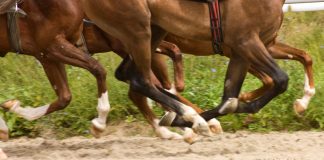 Summer marks the definitive end of hibernation from cold weather and the return to daily riding and weekend shows. As the season wears on, however, the temperature rises, and monitoring horses for overheating and dehydration becomes crucial.
Summer marks the definitive end of hibernation from cold weather and the return to daily riding and weekend shows. As the season wears on, however, the temperature rises, and monitoring horses for overheating and dehydration becomes crucial.
An average equine temperature is between 97.5 to 101 degrees Fahrenheit; environmental factors can affect a horse’s temperature by as much as three degrees. It’s important to know what your horse’s normal temperature is, so practice taking it under regular conditions to establish a baseline. Use a rectal veterinary thermometer, and wait until it beeps for an accurate reading. Contact your veterinarian if your horse’s temperature rises above his normal range.
If you have any question as to whether your horse is dehydrated, pinch the skin on the flat of his neck. It should bounce back to its natural position right away when you let go. If it remains “tented” for more than one second, your horse is dehydrated. The longer the skin stays tented, the more dehydrated he is. In severe cases, your vet may need to administer intravenous fluids.
Another way to check for dehydration is by looking at your horse’s gums. “They should be pink and glistening,” Bloomer says. “If they are dry and/or pale, the horse is likely dehydrated.”
If your horse is hot because of the weather, you can allow him to drink as much water as he wants. However, if he’s hot due to exercise, you’ll want him to drink small amounts gradually over a period of 30 minutes to one hour. During that time, you should also take steps to decrease his body temperature and walk him to cool out.
Running cold water over the large veins on the inside of your horse’s back legs will help drop his body temperature. Placing ice water over his back and loins will lower his internal temperature and might be necessary in the event of possible heatstroke.
Also beware of anhydrosis, a serious condition in which a horse’s ability to sweat is partially or totally compromised. “If a horse is breathing more rapidly than normal [about 10 to 15 breaths per minute] at any time of day, check to see if he’s sweating, and call the vet if he’s not,” Bloomer says.
Make sure your horse has access to clean, cool water at all times. An average 1,000-pound horse should drink a minimum of five gallons per day and can easily drink twice as much or more in hot weather.
To encourage your horse to drink, you can flavor the water by adding a small amount of molasses, apple juice or Gatorade. Always give your horse a choice of plain and flavored water so he has an option. Horses will also benefit from electrolytes added to their feed or water after exercising in extremely hot weather. Be sure to follow the manufacturer’s recommendations when using these products.
If your horse shows signs of overheating and is not responding to cold-water treatments, call your veterinarian immediately.
Further Reading
Ten Tips to Stay Safe with your Horse in Hot Weather
Summer Heat Poses Threat to Horses







this is so helpful. i had no idea there was so many things that happened if ur horse was dehydrated. also its really cool that ur horse can drink gatorade… does powerade work too??
I think this is great! I live in florida and it gets really hot here so its nice to know the do’s and dont’s
Powerade has a higher sugar content- gatorade is best for dehydration. Too much sugar is not good.
I never ride my horse when its higher than 100 degrees.. its too hot for me, so its way too hot for him. we have some REALLY hot summers!
use equine electrolytes over food. that seems to be the best and easiest way to ensure intake and consumption amounts. Usually you’ll do a couple scoops a day before long workouts or trail rides, then up to 6-10 scoops depending on brand the day of heavy exercise.
This was a very good article and I hope people do not ride there horses to much in the heat!!!!
This is a good article. I know people who run their horses all day in the heat and I hope they read this! Be careful if you use Gatorade though because I gave some to my pony once and he had a bad allergic reaction! His face was covered in welts and he looked horrible.
Interesting! Happy 1st Day of Summer to everyone!
thanks ive been wondering about my horse its been really hot for a few days!
Wow this information is just in time…I was just wondering whether I should be riding right now, and if so, how much. Thanks!
Good to keep in mind. Even though we get triple digits here with no humidity we still ride. But, we always keep an eye on the horses and keep their safety a priority.
I’ve been wondering, shouldn’t we be using dew point instead of humidity when calculating the heat index for riding purposes?